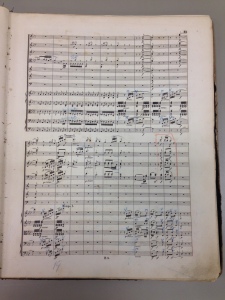On October 16 and 17, 1891, founder and first music director Theodore Thomas led the Chicago Orchestra’s inaugural concerts at the Auditorium Theatre. A group of more than fifty businessmen—including Chicago pioneers Armour, Fay, Field, Glessner, McCormick, Potter, Pullman, Ryerson, Sprague, and Wacker—had agreed to serve as guarantors, each pledging their continued financial support.
At the Smithsonian’s National Museum of American History in Washington, D.C., this giving spirit is the focus of a long-term Philanthropy Initiative announced on #GivingTuesday that includes a new display, “Giving in America” unveiled on December 1, 2015, and on view through November 2016. Included in this display is a very special artifact from the Chicago Symphony Orchestra’s Rosenthal Archives: the oldest of Thomas’s scores for Beethoven’s Fifth Symphony, a work prominently featured on those inaugural concerts.

CSO archivist Frank Villella and Newberry Library manuscripts and archives librarian Alison Hinderliter examine the score
In the Thomas collection, there are four copies of Beethoven’s Fifth Symphony: three are held in the Rosenthal Archives and one at the Newberry Library. Several months ago, Newberry Library manuscripts and archives librarian Alison Hinderliter and I carefully evaluated all four copies. While it’s impossible to determine exactly which score was used for the October 1891 concerts, we decided the most likely candidate was the oldest of the four scores. That particular edition clearly bears Thomas’s markings—particularly bowings in the string parts—along with the conductor’s personal stamp on numerous pages. Several weeks ago, it was carefully packaged and shipped to Washington, D.C. for the exhibit.
According to museum’s website, the preview cases for “Giving in America,” will “provide a look at how philanthropy has shaped American civic culture in two eras—the Gilded Age (1870s–1900) and the present day. The display showcases the role of philanthropy in creating some of the nation’s most enduring museums, libraries, orchestras, universities, and hospitals. It also examines the involvement of women in nineteenth-century philanthropy. Artifacts include a register book showing the 1,600 libraries financed by Andrew Carnegie, an 1881 gown designed by Charles Frederick Worth for philanthropist Mary Eno Pinchot . . . a nurse’s cap worn by a Johns Hopkins School of Nursing student (circa 1945), and current civic philanthropy stories.”
For more information, visit http://americanhistory.si.edu.




Leave a comment
Comments feed for this article